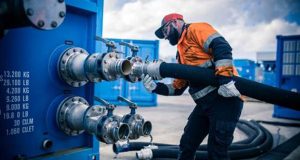Whether FMs are working with a team of engineers or security guards, or working in an industrial, manufacturing, catering or food production environment, PPE is very much about workwear
Traditionally, it has been the role of whoever is responsible for providing PPE within a business to ensure that this adequately protects an employee with equipment and clothing that bears the CE mark and meets the relevant industry EN standards – and all at the best possible price. However, the importance of PPE was recently launched into the Health and Safety spotlight with the adoption of Regulation (EU) 2016/425 earlier this year in April. Formerly a directive, PPE legislation is now a legally binding regulation. It is the client’s responsibility to ensure that a rigorous risk assessment is carried out and that the right protective workwear is supplied and replaced after it is no longer suitable.
 PPE standards ensure that garments are tested and subsequently perform to universal standards but a one-size-fits-all approach is inadequate. A trustworthy, informed and experienced workwear provider should not just provide workwear that meets PPE requirements, but also share knowledge with customers on the suitability, benefits and corresponding protection offered by one garment over another. Johnsons Apparelmaster works tirelessly with Alsico, to ensure the use of the most advanced fabrics.
PPE standards ensure that garments are tested and subsequently perform to universal standards but a one-size-fits-all approach is inadequate. A trustworthy, informed and experienced workwear provider should not just provide workwear that meets PPE requirements, but also share knowledge with customers on the suitability, benefits and corresponding protection offered by one garment over another. Johnsons Apparelmaster works tirelessly with Alsico, to ensure the use of the most advanced fabrics.
But, no matter how advanced the technology of the fabric, all protective workwear must be kept in a clean condition to function correctly. This is particularly relevant with high visibility clothing. Dirty clothing will reduce the visible performance of the garment and the wearer may be at risk. Incorrect processing may permanently damage the fluorescent material and the retro-reflective tape.
There is no universal laundry process for PPE workwear. All garments are manufactured from different fabric and trims. These need to be washed in a specific way or dry cleaned. Responsible suppliers will undertake extensive wash tests to ensure that the garments provided and/or the process are fit for purpose, before they are supplied to an end user. Some garments require ongoing surface treatments to ensure that they remain fit for purpose. It is important that the end user is clear about the standards to which they need to adhere and it is the responsibility of suppliers to outline the best PPE workwear options available to them.
It’s not always enough to know that employees are wearing garments that meet regulations – employers may also need to be able to prove that this is the case. For example, in one shipyard that contacted Johnsons Apparelmaster to discuss the safety of their flame retardant workwear, a Health and Safety issue had arisen because the shipyard could not prove that their garments were still flame retardant. They had no idea of knowing how many times their overalls had been washed and were unable to prove how they had been washed. Through a bespoke rental workwear service for 400 employees, each employee was assigned three separate barcoded garments which allowed one for wearing, one for washing and one as a spare. As a result, the shipyard benefited from a detailed, real-time audit trail and could prove that their workwear met
all compliance guidelines.
 Going forward, workwear providers can guide the way for customers, using technology, innovation and data collection to create process improvement, ensuring that PPE workwear is replaced once it is no longer effective in protecting the wearer and that adequate stock controls are in place for existing and new staff. They can also provide real-time reports and accurate information for audit and compliance trails.
Going forward, workwear providers can guide the way for customers, using technology, innovation and data collection to create process improvement, ensuring that PPE workwear is replaced once it is no longer effective in protecting the wearer and that adequate stock controls are in place for existing and new staff. They can also provide real-time reports and accurate information for audit and compliance trails.
Often branding and bespoke adjustments to PPE clothing can also negate standards to which the garment previously adhered, and mistakes can occur out of ignorance rather than negligence. Workwear providers have a key responsibility to work with their clients to ensure that PPE is not compromised by mistakes like these or by employees failing to care for their protective workwear. Often the successful introduction of new garments to the end user relies on a balance of wearer comfort and protection. Protection can often be reduced if the garment is not worn correctly. Suppliers must take time to engage with the wearer, listening to what they would like while explaining the client’s obligation from a Health & Safety perspective and/or risk assessment. If the wearer has a greater understanding about the steps that their company is taking to ensure their comfort and safety, the more likely they are to wear the garments in the correct way.
Here are some hints and tips for choosing a workwear and laundry specialist:
- Ensure your supplier is continually keeping abreast of relevant European standards, and developments in new fabrics, technology and servicing options.
- Ensure your supplier is proactive in sharing knowledge to highlight and explain standards in a way that is both meaningful and useful; that they explain the suitability, benefits and corresponding protection offered by one garment over another; and that they will educate staff in the correct use of PPE workwear.
- Ensure extensive wash tests so that the garments provided and/or laundry process are fit for purpose.




